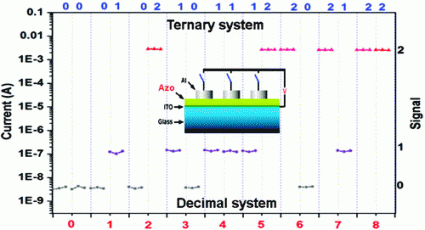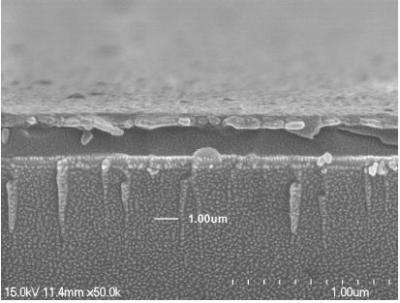April 14, 2010 report
Organic ternary data storage device developed

(PhysOrg.com) -- The memory capacity of electronics devices could be increased in future thanks to an organic data storage system using ternary rather than binary data storage. The current prototype is designed for permanent data storage, and can be written once but read multiple times, but the Chinese researchers hope to develop re-writable data storage based on the technology.
Binary systems record data as a switchable series of zeros and ones, whereas ternary systems record data as zeros, ones or twos, which are also electrically switchable states. The extra value theoretically means much more data could be stored in the same amount of storage space. Ternary systems already exist, but are mostly experimental.
A new system, developed by Hongwei Gu and Jianmei Lu and colleagues at Soochow University, Suzhou in eastern China, is a ternary system using a new synthesized organic azo compound sandwiched between aluminum and indium tin oxide (ITO) electrodes. Each electrode unit acts as a data storage unit, which acts in a similar way to the magnetized patches in a hard disk that store data. When a voltage is applied to the aluminum electrode, the ease of electron flow (and density of molecular stacking) in the azo compound is changed to a low, medium or high conductivity state that corresponds to zero, one, or two respectively.

A group of scientists, led by Ritesh Agarwal at the University of Pennsylvania, have previously used inorganic compounds to develop a reliable ternary data storage that is erasable, but Lu and Gu’s prototype is the first reliable ternary system using an organic compound in a permanent data storage device.
High-density data storage (HDDS) systems are needed to store the ever increasing amounts of information. The prototype developed at Soochow University could lead to a massive increase in the potential memory density in future electronics devices.
The paper is published in the Journal of the American Chemical Society.
More information: A Small-Molecule-Based Ternary Data-Storage Device, J. Am. Chem. Soc., Article ASAP, DOI:10.1021/ja910243f
© 2010 PhysOrg.com



















